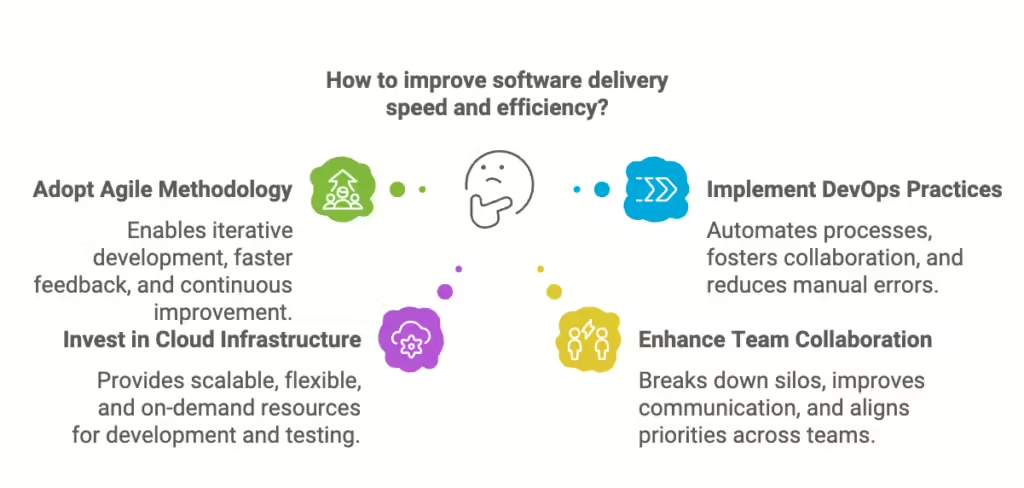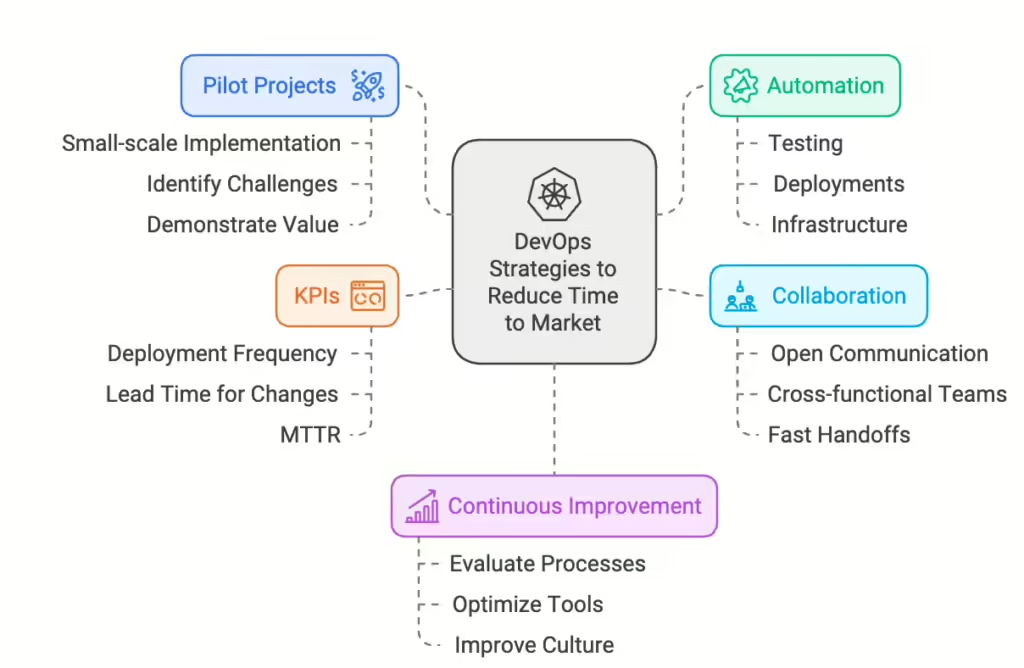In today’s fast-paced digital world, the ability to quickly adapt to market demands is paramount to an organization’s success. One of the key metrics that businesses focus on to maintain a competitive edge is “time to market”—the speed at which a product or feature moves from conception to delivery.
This acceleration in delivery timelines has a direct impact on revenue, customer satisfaction, and overall market share.
DevOps, a set of practices that combines software development (Dev) and IT operations (Ops), has revolutionized how companies approach software delivery by reducing time to market significantly.
In this article, we will explore how DevOps enables faster time to market, the tools and methodologies involved, and practical strategies for implementation.
Understanding Time to Market in Software Development
Before delving into how DevOps improves time to market, it is essential to understand the key factors that impact delivery timelines in traditional software development cycles:
- Development Delays: In traditional models, development often occurs in isolated stages. Each phase, such as requirements gathering, design, coding, testing, and deployment, tends to be sequential, leading to long cycle times.
- Manual Processes: Many stages in traditional software delivery rely on manual efforts, such as environment provisioning, code deployment, and testing. These manual steps introduce inefficiencies and are prone to human error, resulting in delays.
- Siloed Teams: Development, testing, and operations teams often work in isolation, leading to miscommunication, conflicting priorities, and bottlenecks in the handoff process. This slows down the entire delivery pipeline.
- Inflexible Infrastructure: Traditional infrastructure management can be slow, especially when scaling environments for testing or production. Provisioning servers, updating configurations, and deploying applications can take days or even weeks.

All of these challenges contribute to slow and inefficient software delivery.
However, the introduction of DevOps has shifted the paradigm, allowing companies to drastically reduce their time to market by streamlining workflows and improving collaboration across teams.
Practical Strategies for Implementing DevOps to Reduce Time to Market

While the benefits of DevOps are clear, implementing DevOps practices can be a complex undertaking. For organizations seeking assistance, DevOps consulting services can provide tailored strategies and support to ensure a smooth transition.
Here are some practical strategies for successfully adopting DevOps to accelerate time to market:
- Start Small with Pilot Projects: Begin by implementing DevOps practices on a small-scale project to demonstrate the value and identify any challenges. Gradually expand DevOps practices to other teams and projects based on learnings from the pilot.
- Invest in Automation Early: Automating testing, deployments, and infrastructure provisioning is key to reducing time to market. Prioritize automation in the early stages of your DevOps journey to reap the benefits faster.
- Foster a Culture of Collaboration: Encourage open communication and collaboration across development, operations, and QA teams. Cross-functional collaboration is critical to breaking down silos and ensuring faster handoffs.
- Measure Key Performance Indicators (KPIs): Continuously measure KPIs such as deployment frequency, lead time for changes, and MTTR to track your DevOps maturity and identify areas for improvement.
- Adopt a Continuous Improvement Mindset: DevOps is not a one-time implementation but an ongoing process of improvement. Continuously evaluate your processes, tools, and culture to optimize for faster delivery times.
How DevOps Accelerates Time to Market
The essence of DevOps lies in automation, collaboration, and continuous improvement. These principles help reduce inefficiencies, allowing teams to deploy faster and more frequently.
Here’s how DevOps accelerates time to market:
1. Continuous Integration and Continuous Delivery (CI/CD)
CI/CD pipelines are the backbone of DevOps. Continuous Integration involves frequently merging code changes into a shared repository, ensuring that the application is always in a deployable state.
Automated tests validate each code change, allowing teams to catch errors early and resolve them quickly.
Continuous Delivery takes this a step further by automating the entire release process. Once code passes the necessary tests, it is automatically deployed to staging or production environments.
This eliminates the need for manual interventions and ensures that features can be delivered quickly and frequently.
By removing the traditional handoffs between development and operations, CI/CD pipelines enable faster feedback loops, reduce errors, and ultimately lead to faster time to market.
2. Infrastructure as Code (IaC)
One of the key benefits of DevOps is the use of Infrastructure as Code (IaC). IaC allows teams to define, provision, and manage infrastructure through machine-readable configuration files rather than manual processes. This approach enables developers to spin up test environments in minutes rather than waiting for weeks for physical hardware to be set up.
Popular tools like Terraform, AWS CloudFormation, and Ansible allow for infrastructure automation, versioning, and easy scaling. With IaC, environments can be easily replicated across different stages of development, ensuring consistency, reducing setup times, and eliminating configuration errors.
3. Automation of Repetitive Tasks
DevOps thrives on automation. By automating repetitive tasks such as testing, code reviews, and deployments, teams can focus more on innovation and feature development. Automation minimizes human error, reduces the time spent on manual interventions, and ensures that each phase of the development process is streamlined and optimized.
For example, unit tests, integration tests, and even performance tests can be automated to provide real-time feedback to developers. Deployment pipelines can automatically push new features to production environments without waiting for manual approvals.
The result? Faster release cycles, lower failure rates, and a significant reduction in time to market.
4. Collaborative Culture and Breaking Down Silos
One of the cultural shifts that DevOps brings is the breaking down of silos between development, operations, and QA teams. DevOps encourages cross-functional collaboration, with all teams working together towards a common goal—faster delivery with fewer errors.
Through shared responsibility and improved communication, teams can collaborate more efficiently, anticipate challenges, and resolve issues faster. This eliminates the delays typically caused by handoffs between siloed departments and ensures that products move from development to production with minimal friction.
5. Feedback Loops and Continuous Improvement
DevOps emphasizes continuous feedback and improvement. Monitoring and logging tools allow teams to receive real-time feedback from production environments, helping them identify performance issues, security vulnerabilities, and bugs early in the development cycle.
This rapid feedback loop enables quicker iterations and ensures that any problems are addressed immediately, further reducing delays.
Additionally, metrics like deployment frequency, lead time, and mean time to recovery (MTTR) help teams measure their performance and identify bottlenecks. With this data, organizations can make informed decisions to optimize their DevOps pipelines continuously.
Tools That Enable Faster Time to Market in DevOps
Several DevOps tools are instrumental in reducing time to market. Some of the most widely used ones include:
- Jenkins: A popular automation server that facilitates CI/CD by allowing teams to automate testing and deployments.
- GitLab: A platform that integrates CI/CD pipelines, version control, and monitoring into a single toolchain.
- Kubernetes: An open-source container orchestration platform that enables automated deployment, scaling, and management of containerized applications.
- Docker: A tool that allows developers to package applications and their dependencies into containers, ensuring consistency across environments and reducing the “works on my machine” problem.
- Terraform: A tool for defining and provisioning infrastructure as code, allowing for rapid environment setup and scaling.
- Ansible: A powerful automation engine that helps manage configurations and deployments across various environments.
These tools, when integrated into a DevOps pipeline, enable faster, more reliable releases, contributing to the overall goal of reducing time to market.
Conclusion
In today’s hyper-competitive digital landscape, reducing time to market is essential for staying ahead of the competition. By embracing DevOps, organizations can accelerate their software delivery timelines through automation, collaboration, and continuous improvement. To fully leverage these benefits, businesses often choose to hire DevOps engineers who bring specialized skills to streamline processes and enhance deployment efficiency.
From CI/CD pipelines to infrastructure as code, DevOps provides the tools and methodologies to streamline every stage of the development process, ensuring faster, more reliable releases.
For companies that successfully implement DevOps, the rewards are significant: faster time to market, reduced operational costs, increased customer satisfaction, and greater agility to respond to changing market demands. To further enhance the success of your DevOps journey, it’s important to consider the DevOps challenges and solutions that may arise, such as managing complex pipelines, handling security concerns, and scaling automation effectively. Addressing these challenges upfront will ensure a smoother, more productive DevOps implementation.
